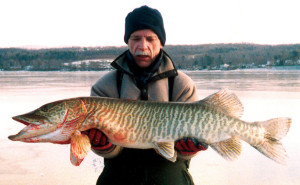Well, after a delayed start due to the warm weather, it looks like there may be enough ice to get out onto the lakes and ponds and do some “hardwater” fishing. Make sure there is enough ice before venturing out onto it. The bulk of the information for this week’s column comes from MassWildlife which has ice strength and safety tips which are listed below. They stress that the figures in the table below are for clear, blue ice on lakes and ponds and caution us to reduce strength values 15% for clear blue, river ice. “Honeycombed” ice, which occurs in the spring or during major winter thaws as the ice is melting, is the most dangerous ice. It is best avoided unless the angler is certain there is a safe layer of solid ice beneath the honeycombed surface.”
They caution us to “be aware that many lakes and ponds contain spring holes and other areas of current that may create deceptively dangerous thin spots in areas that are otherwise safe. Always use caution, and don’t venture out onto unfamiliar waters without checking ice thickness frequently.”
| Ice Thickness and Strength | |
| Ice Thickness (inches) | Permissible Load (on new* clear/blue** ice on lakes or ponds) |
| 2″ or less | STAY OFF! |
| 4″ | Ice fishing or other activities on foot |
| 5″ | Snowmobile or ATV |
| 8″-12″ | Car or small pickup truck |
| 12″ – 15″ | Medium truck |
| *New ice is stronger than older ice. **White ice or “snow ice” is only about half as strong as new clear ice. Double the above thickness guidelines when traveling on white ice. | |
“There are no guarantees. Always consider ice potentially dangerous. Assess ice safety by using an ice chisel to chop a hole in the ice to determine its thickness and condition. Make sure you continue to do this as you go further out on to the ice, because the thickness of the ice will not be uniform all over the pond or lake. Be aware that ice tends to be thinner on lakes and ponds where there are spring holes, inlets or outlets. Don’t venture onto ice-bound rivers or streams as the currents make ice thickness unpredictable.”
MassWildlife cautions that if you, a companion, or pet fall through the ice, don’t panic! Call for help if there are people nearby. While it doesn’t take long for the cold water to start slowing your physical and mental functions, you have more time than you might think; typically 2-5 minutes and perhaps longer if you are in good, physical condition. Air will remain trapped in your clothes for a short time aiding your buoyancy. Kick your legs while grasping for firm ice. Try to pull your body up using “ice pins” that should be hanging around your neck. Once your torso is on firm ice, roll towards thicker ice. This will better distribute your weight. Remember that ice you previously walked on should be the safest.
After you reach safe ice, don’t waste precious time, you need to warm up and dry out. If you are in a remote area, this means getting to or starting a campfire. If you are in a more urban setting get to a car or house. Once there, get out of wet clothes, change into dry clothes to get warmed up and seek advice from your physician on medical attention. You need to warm up quickly to prevent hypothermia.
If a companion falls through the ice remember the phrase “Reach-Throw-Go”. If you are unable to reach your friend from shore, throw him or her a rope, jumper cables, tree branch, or other object. If this does not work, go for help before you also become a victim. Get medical assistance for the victim immediately.
When walking on or near ice, keep your pets on a leash. If a pet falls through the ice do not attempt to rescue the pet, go for help. Well meaning pet owners can too easily become rescue victims when trying to assist their pets.
Incidentally, the Stockbridge Sportsmen’s Club Echo Lake derby, which was scheduled for next weekend, has been cancelled due to ice conditions. *****
It is unclear whether the Onota Boat Livery will be preparing a list of local ice fishing derbies this year. If not, I would be happy to list them in this column. Please get the information to me at least 2 week in advance of the event. Information needed: Date, Name of Event, Location, times, entry fee, and contact phone number. *****
First-time hunters who wish to purchase a Massachusetts hunting or sporting license must complete a Basic Hunter Education course. This course is designed for first-time hunters and is standardized across North America.
The following local Basic Hunter Education courses are scheduled as follows: Pittsfield High School, 300 East Street, Pittsfield, March 1, 3, 8, 10, 15 and 17. Cheshire Rod & Gun Club, 310 Curran Road, Cheshire, March 7, 11, 14, 18, 21 and 25. Both are 6 class sessions which run from 6 to 9 PM. You must attend all class dates and times to successfully complete the course.
I am mentioning this months in advance because the courses fill up quickly. If you are interested in this course and wish to enroll, please call 508-389-7830 immediately; students are enrolled first-come, first-served, and enrollment cannot be processed via email. *****
The sportsmen of Berkshire County have lost yet another well known sportsman, Kenneth R. Larabee, Sr from Cheshire. He was an avid bass fisherman who founded the Northern Berkshire Bass Club and was the past president of the Tunnel City Bass Club. Our condolences go out to his wife Sandra and family. The tournament bass fishermen of Northern Berkshires will truly miss him.
Questions/comments: berkwoodsandwaters@roadrunner.com. Phone/fax: (413)637-1818.

